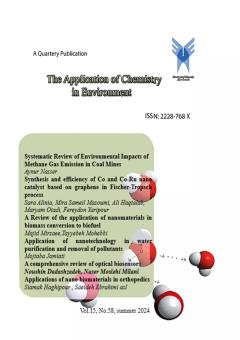Application of nanotechnology in water purification and removal of pollutants
Subject Areas : Chemistry and Chemical Engineering of all specializations
1 - Department of Physics, Naragh Branch, Islamic Azad University, Naragh, Iran
Keywords: : nano technology, catalyst, pollutants, membrane, nano filter,
Abstract :
Water is one of the most essential elements of life on earth, and although more than 70% of the earth's surface is covered with water, less than 3% of it is fresh water. Of this amount, 79% belongs to the ice peaks, 20% is underground water that is not easily accessible, and in total, only one ten thousandth of the total water on the planet is easily accessible to humans at any time. The availability of safe and clean water is one of the most important issues facing mankind, and gradually, as the amount of water consumption increases, pollutants also contaminate water sources in various ways, and this issue will become more critical in the future. . Accepting the right to enjoy water as a human right may be the most important step in solving the difficulty of providing this most basic element of people's lives. Nanotechnology has led to tremendous changes in the use of natural resources, energy and water and has reduced sewage and pollution. In the new nano technology, by using various methods, it is possible to recycle water from polluted waste water for agricultural, industrial and even domestic purposes. Also, nano technology has the ability to remove small pollution from water sources (less than 200 nm) and air (below 20 nm) and continuously measure and reduce pollution in larger areas. Due to the effective removal of pollutants and the reduction of the costs of water production, the use of nanotechnology has received more attention and acceptance from the people than the old methods.
[1] Mohammadi, S., 2013, Nano technology applications in water industry and environment. Proceedings of the 8th Iran Chemistry Education Seminar 2013 August 28-29, Faculty of Chemistry, Semnan University.#
[2] McCarthy, A.A., 2005, Dendritic NanoTechnologies, inc. Chem. Biol., 12 (5), 499-501.#
[3] Ponomarev, P., 2009, Study and application of flotation in schemes for waste water purification. Environ. Res. Eng. Manag., 50 (4), 51-56.#
[4] Jamiati, M., 2021, Modeling of MaximumSolar Power Tracking by Genetic Algorithm Method. Iranian (Iranica) Journal of Energy & Environment, 12(2), 118–124.#
[5] Malode, S. J., Prabhu, K. K., Shetti, N. P., 2020, Electrocatalytic behavior of a heterostructured nanocomposite sensor for aminotriazole. New J. Chem, 44(44), 19376-19384.#
[6] Zhao Z., Zheng J., Wang M., Zhang H. & Han C. C., 2012, High performance ultrafiltration membrane based on modified chitosan coating and electrospun nanofibrous PVDF scaffolds. J. Membr. Sci., 394–395, 209–217.#
[7] Jassby, D., Cath., T.Y. and Buisson, H., 2018, The role of nanotechnology in industrial water treatment. Nature Nanotech, 13, 670–672.#
[8] Schertel, L., Vignolini, S., 2020, Nanotechnology in a Shrimp Eye’s View. Nature Nanotechnology, 15, 87-88.#
[9] Barman J., Tirkey A., Batra S., Paul A.A., Panda K., Deka R., Babu P.J., 2022, The role of nanotechnology based wearable electronic textiles in biomedical and healthcare applications. Mater. Today Commun, 32, 104055.#
[10] Karimi, S., Ramezani Etedali, H., Sotoodehnia, A., 2024, Investigation of Arsenic Removal from Drinking Water Using Alum Coagulant. Journal of Water and Wastewater Science and Technology (JWWSE), 8(4), 4-10.#
[11] Patil, A., Mishra, V., Thakur, S., Riyaz, B., Kaur, A., Khursheed, R., Patil, K., Sathe, B., 2019, Nanotechnology Derived Nanotools in Biomedical Perspectives: An update. Current Nanoscience, 15, 137-146.#
[12] Jamiati, M., Mehdipour, K. P., 2020, The calculation of total fragment excitation energy for photofission of Uranium isotopes. Turkish Journal of Physics, 44(4), 364–372.#
[13] Lv, P., Xie, D., Zhang, Z., 2018, Magnetic carbon dots based molecularly imprinted polymers for fluorescent detection of bovine hemoglobin. Talanta, 188, 145-151.#

